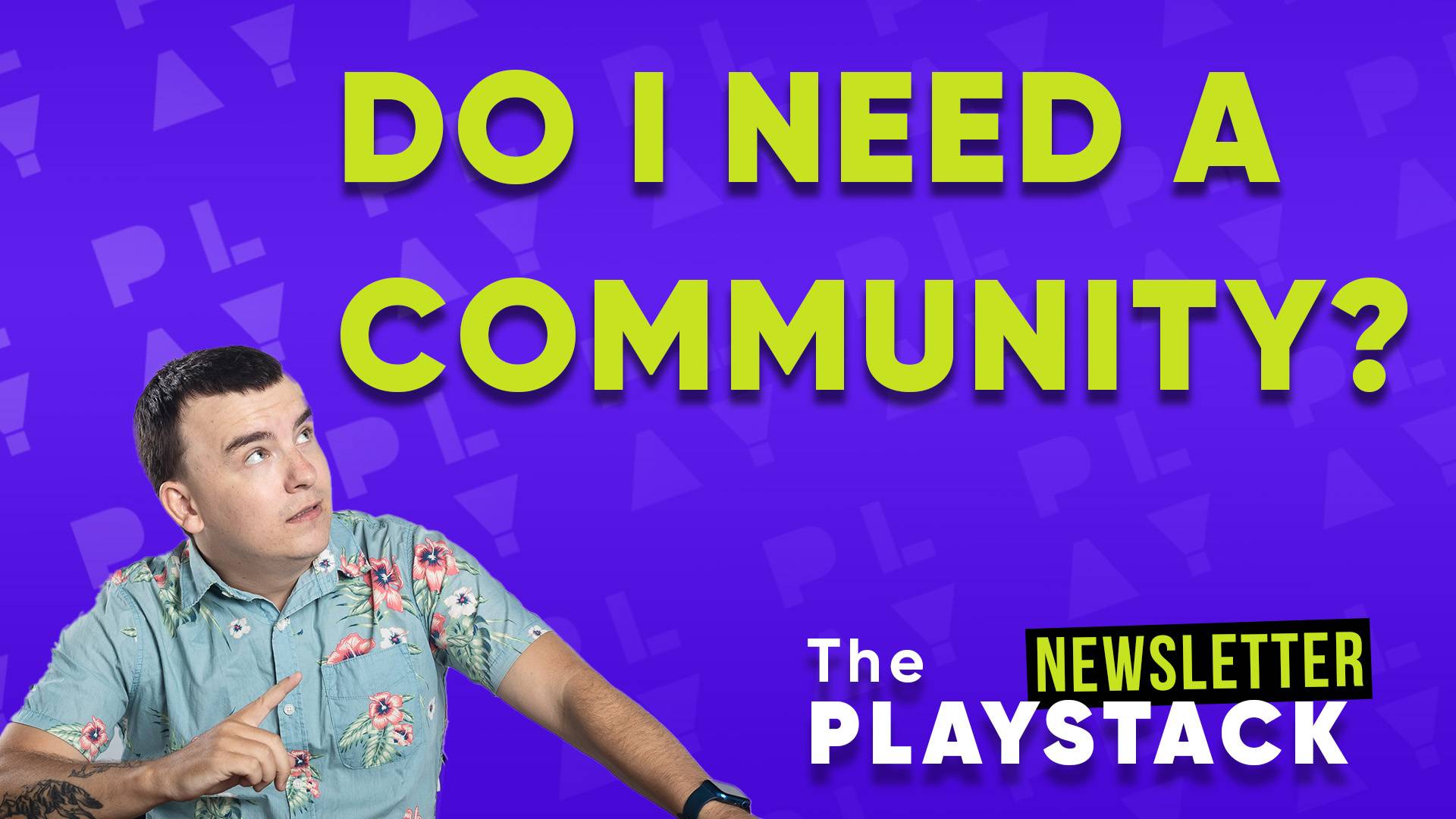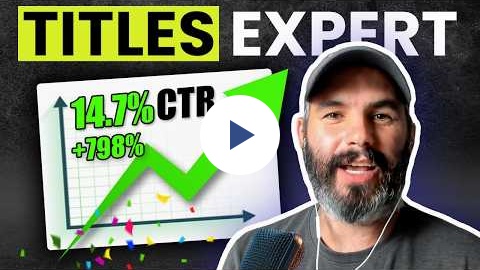This will get you 100% more views

Hey Reader,
Thanks for reading the 3rd edition of The Playstack Newsletter.
I'm excited about this one as it's close to what we do at Playstack, building a community and why it's important for your business.
Make sure to check out our podcast guest from last week who will teach you everything about writing the perfect YouTube title.
Should you start a community?
As a creator or business owner, it’s often pretty straightforward how we monetize our... things. But are we always succeeding at that and how can we make it easier?
With things, I guess I mean your products or services, to sell we gotta get leads and to get leads we need to convert, convert traffic.
That traffic, in my opinion, is the hardest part (unless that’s what you nailed first and now you are trying to build a business from that). So this segment is for either those who have traffic, have an offer, or neither... Listen up.
We are talking communities and why they can change your business, they did for us.
To understand what communities in this context are, I’ll break down the types of and their requirements and benefits. Then I’ll roll into why this can be a good option for you, or to start before that, why you should be in one.
Understanding the Problem
Back to “selling our things”... Whether that’s our services, products or time. Success comes from addressing real issues people face, not just jumping on trends like drop-shipping or affiliate marketing and hope we find a market for it.
Everything is about market fit, does your “thing” solve a problem? Help people make more money, entertain them, save time, reduce stress, …
I can then go into what else you need to do like finding your Ideal Customer Persona (ICP) and how to build your offer around that but that’s not the point of this letter.
The point is how we can use communities to make more money or to find the problem we are trying to solve.
Community Types
There are four main types of communities:
- Peer Communities: These are low-cost, high-engagement spaces where people with common interests connect, like book clubs or hobby groups. However, they require a large audience to be profitable. The value comes from member interaction.
Expertise needed: None
Traffic needed: A lot
Monetization: Low
Pros: This is great for when you are trying to look for problems you want to monetize, you are in your early stages and interested in certain topics.
Cons: Needs a lot of engagement and effort to grow this, you are basically the middle person between everyone with a similar interest and bringing them together.
- Proximity Communities: High-ticket communities that offer direct access to an expert or a small group of peers. These are more exclusive and provide higher value, often through regular meetings and deep interaction.
Expertise needed: high
Traffic needed: A little
Monetization: High
Pros: This is a one-to-many model so more effective than one-to-one coaching. A group of high-profile people. It’s very structured with regular meetings.
Cons: Needs a lot of trust, credibility and results for people to join.
- Community-Powered Courses: These combine online courses with community elements, enhancing the learning experience through accountability and peer support. They typically charge a lower ticket but offer substantial value through group interaction.
Expertise needed: Medium
Traffic needed: Medium
Monetization: Medium
Pros: Courses are very popular to start when you have some expertise that you want to monetize, yet people often never finish the course so building a community that provides that accountability and similar to a peer community, brings people together.
Cons: Still needs a lot of managing and making sure the engagement and accountability are actually there.
- Transformational Communities: The most intensive and expensive type, these communities focus on delivering a specific outcome, like becoming a premium Ghostwriter. They offer daily support and accountability, often cohort-based.
Expertise needed: High
Traffic needed: Low
Monetization: High
Pros: Scalable as it’s a One-to-many model again. very focussed on one outcome so everyone in this community is focussed on that.
Cons: Needs a lot of trust, credibility, and results for people to join. Time-consuming to make sure your students/community is getting the results they wish for.
Now that you have an idea of what can fit your style or position you need to think about how to price this.
Pricing
Creators and business owners often struggle with pricing their communities, underestimating the value they provide. The goal is to align your pricing with the value and outcomes you deliver.
How big is the problem you are solving?
You are teaching someone to get 2x views on YouTube and that would mean more leads to their service business through weekly calls with a high-level community with people who had similar struggles, resulting in an extra $50k a year in revenue. Would 10% of that problem be worth charging?
Or
Are you helping people make their first dollar on LinkedIn, a course that breaks everything down but they need to put in all the effort to get through the course and implement it all, accountability here is key.
Don’t undervalue yourself or your offer, yet finding the right audience for this is key.
Sustainability and Engagement
From our experience communities require ongoing engagement and value delivery to retain members.
That makes it harder for Community-Powered Courses to keep their members active once they have all the value if you are not adding more to the course or encouraging people to engage.
Proximity Communities and Transformational Communities are easier to keep active as people can get massive results that can change their lives or business. Having regular live touchpoints amongst high-level players encourages the community to stay active.
For someone new, starting a community might not be the easiest path; it’s better suited for those with clear expertise or an existing audience.
Before we launched our Playstack Mastermind Community we started a free community for creators and business owners who were looking to grow their YouTube, by doing this we learned a lot about what the real problems are that people are struggling with.
So one thing we see a lot is a tiered access community, that attracts free members and upsells them to paid coaching.
The community should set clear expectations from the start to avoid member dissatisfaction and churn.
All of the above was discussed in How to make $10k/month from a community - Jordan Godbey in Deep Dive with Ali Abdaal
Mike and I had a great conversation with Jay Clouse on what makes a community so successful, one big topic was addressing this member dissatisfaction and churn. The answer to that was the onboarding process.
If you want to get more into that part make sure to check out our episode with Jay.
As mentioned we host our own community, The Playstack Mastermind, where we help businesses and anyone like course creators and creators grow and monetize their YouTube, faster, more effectively and bigger.
For more information, book a discovery call, we are happy to help out with any of your bottlenecks in the creation and conversion process.
Worth Watching
Part of what I do daily is consume a lot of content and here are some of my favorites:
- LegalEagel - MrBeast: Illegal Rigging, Lotteries, & NDAs?
They jumped on a big trend around MrBeast and provided their expert opinion. - Dr. Plants - Simulating Africa for 100 Days
Top storytelling with a miniature version of life in the desert. - Nick Bare - The Speed Project | 300 Mile Ultra from LA to Vegas
Beautiful cinematics with next-level storytelling about a difficult running challenge. - Colin And Samir - How YouTube accidentally beat Netflix
What is the future of YouTube and Netflix, are they competing?

Why Most YouTube Titles Fail (And How to Avoid It) | Jake Thomas
Mike Dee and I spoke to the YouTube Title Wizard, Jake Thomas
Here’s why your titles matter more than you think:
First Impressions:
A good title is your video’s handshake. Make it count.
Curiosity Drives Clicks:
Open loops and questions in your title make viewers need to know more.
SEO Matters:
Keywords in your title help your video get discovered by the right audience.
Promises Made, Promises Kept:
Your title sets an expectation—make sure your content delivers.
Continuous Testing:
The best creators constantly test different titles to see what resonates.
Don't let a weak title undermine great content. Perfect your titles as the first step in increasing your views.
Jake Thomas and Creator Hooks are sponsoring this newsletter so make sure to check out his tool that will help you write better YouTube titles for more views.
Want to work with me to grow your business?
If you’re a 7-8-figure founder or agency that wants to grow your YouTube channel, membership, and course — I’d love to work with you.
For 6-figure+ founders and channels, join an exclusive group with 5,500,000+ total subscribers.
Get access to founders, agencies, course creators, community builder and more...



.jpeg)
.jpeg)
.jpeg)